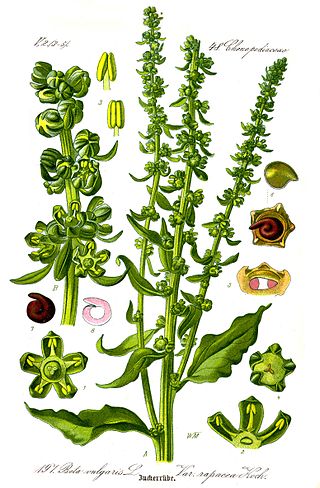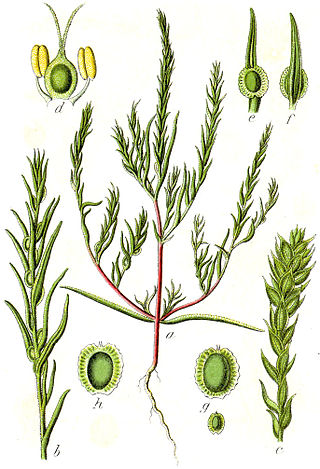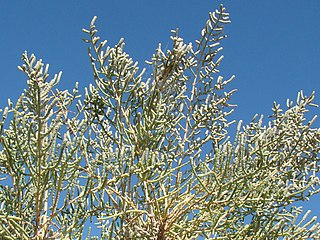
Amaranthaceae is a family of flowering plants commonly known as the amaranth family, in reference to its type genus Amaranthus. It includes the former goosefoot family Chenopodiaceae and contains about 165 genera and 2,040 species, making it the most species-rich lineage within its parent order, Caryophyllales.
Sarcocornia is a formerly recognized genus of flowering plants in the amaranth family, Amaranthaceae. Species are known commonly as samphires, glassworts, or saltworts. Molecular phylogenetic studies have shown that when separated from Salicornia, the genus is paraphyletic, since Salicornia is embedded within it, and Sarcocornia has now been merged into a more broadly circumscribed Salicornia. When separated from Salicornia, the genus has a cosmopolitan distribution, and is most diverse in the Cape Floristic Region of South Africa.

The Salicornioideae are a subfamily of the flowering plant family Amaranthaceae. Important characters are succulent, often articulated stems, strongly reduced leaves, and flowers aggregated in thick, dense spike-shaped thyrses. These halophytic plants are distributed worldwide. Many are edible

The Salsoloideae are a subfamily of the Amaranthaceae, formerly in family Chenopodiaceae.

The Chenopodioideae are a subfamily of the flowering plant family Amaranthaceae in the APG III system, which is largely based on molecular phylogeny, but were included – together with other subfamilies – in the family Chenopodiaceae, or goosefoot family, in the Cronquist system.

Chenopodium is a genus of numerous species of perennial or annual herbaceous flowering plants known as the goosefoot, which occur almost anywhere in the world. It is placed in the family Amaranthaceae in the APG II system; older classification systems, notably the widely used Cronquist system, separate it and its relatives as Chenopodiaceae, but this leaves the rest of the Amaranthaceae polyphyletic. However, among the Amaranthaceae, the genus Chenopodium is the namesake member of the subfamily Chenopodioideae.

Beta is a genus in the flowering plant family Amaranthaceae. The best known member is the common beet, Beta vulgaris, but several other species are recognised. Almost all have common names containing the word "beet". Wild Beta species can be found throughout the Atlantic coast of Europe, the Mediterranean coastline, the Near East, and parts of Asia including India.

Halothamnus is a genus in the subfamily Salsoloideae of the family Amaranthaceae. The scientific name means "saltbush", from the Greek ἅλς 'salt' and θαμνος 'bush'. This refers either to salty habitats or to the accumulation of salt in the plants. The genus is distributed from Southwest and Central Asia to the Arabian peninsula and East Africa.

The Betoideae are a small subfamily of the flowering plant amaranth family, Amaranthaceae sensu lato. Commonly known members include beet, sugar beet, chard, and mangelwurzel, which all are cultivars of Beta vulgaris.

Camphorosmeae is a species-rich tribe of the Amaranthaceae, formerly Chenopodiaceae, with 20 genera and about 179 species. It is classified as a single tribe of subfamily Camphorosmoideae.

The Suaedoideae are a subfamily of plants in the family Amaranthaceae.

The Corispermoideae are a subfamily of the Amaranthaceae, formerly in family Chenopodiaceae.

Dysphania is a genus of plants in the family Amaranthaceae. Species of the genus are found worldwide from the tropics and subtropics to warm-temperate regions.

Halostachys is a genus of flowering plants in the plant family Amaranthaceae, containing a single species, Halostachys caspica. The plants are small to medium halophytic shrubs with apparently jointed fleshy stems and scale-like leaves. They are native to western and central Asia and northern China.

Kalidium is a genus of flowering plants in the plant family Amaranthaceae. The species are shrubby halophytes distributed in Southeast Europe, Southwest Asia and Central Asia to China.

Heterostachys is a genus of flowering plants in the plant family Amaranthaceae. The two species are shrubby halophytes native to South America and Central America.

Allenrolfea is a genus of shrubs in the family Amaranthaceae. The genus was named for the English botanist Robert Allen Rolfe. There are three species, ranging from North America to South America.
Arthrocnemum was a genus of shrubs in the family Amaranthaceae. Two or three species were included in the genus. They are halophytes with fleshy, apparently articulated plant stems and reduced leaves and flowers.

Patellifolia is a genus of flowering plants in the subfamily Betoideae of the family Amaranthaceae. These are mostly procumbent herbs occurring in the Western Mediterranean region and Macaronesia, with some isolated occurrences in North Africa and at the Horn of Africa. They are interesting as crop wild relatives of sugar beet.

Surreya is a genus of flowering plants belonging to the family Amaranthaceae. It is also in the Polycnemoideae subfamily.


















